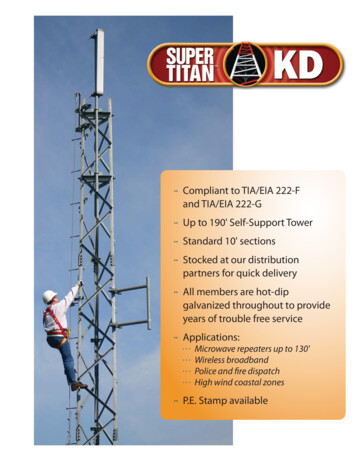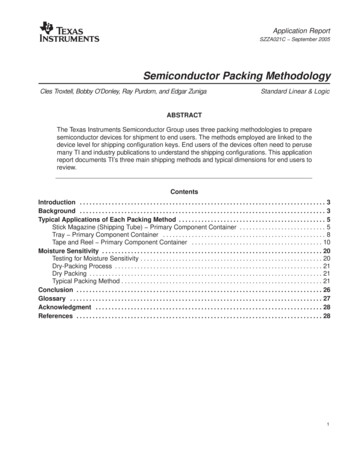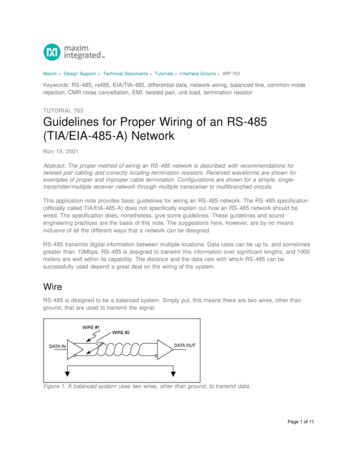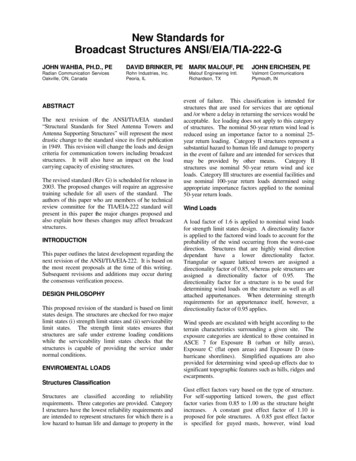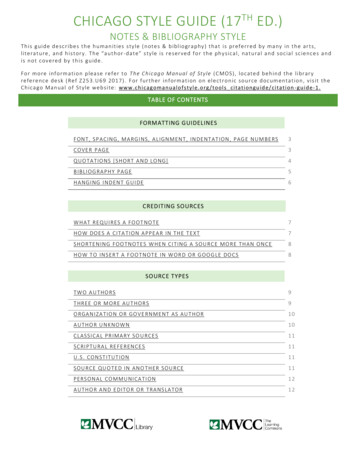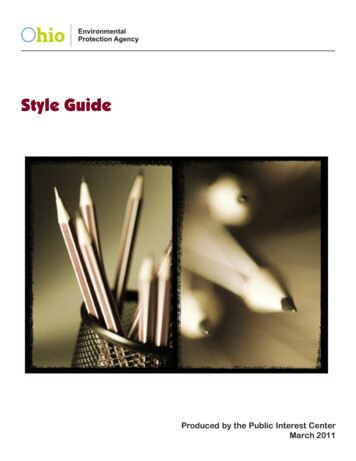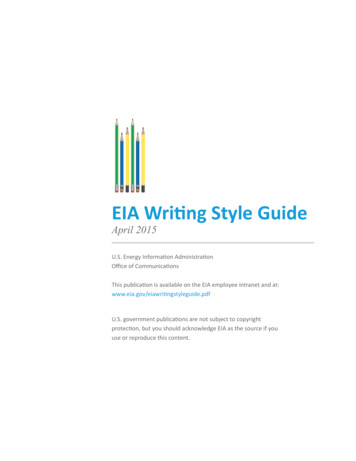
Transcription
EIA Writing Style GuideApril 2015U.S. Energy Information AdministrationOffice of CommunicationsThis publication is available on the EIA employee intranet and at:www.eia.gov/eiawritingstyleguide.pdfU.S. government publications are not subject to copyrightprotection, but you should acknowledge EIA as the source if youuse or reproduce this content.
ContentsIntroduction to the EIA Writing Style Guide .1Chapter 1: Editorial Voice and Words and Phrases To Avoid .9Chapter 2: Policy-Neutral Writing .19Chapter 3: Advice for Good Writing .21Chapter 4: Grammar .29Chapter 5: Commonly Misused Words .33Chapter 6: Capitalization .47Chapter 7: Numbers .57Chapter 8: Commas .67Chapter 9: Hyphens and Dashes .73Chapter 10: Colons and Semicolons .83Chapter 11: Periods .87Chapter 12: Symbols .91Chapter 13: Punctuating and Formatting Quoted Text .93Chapter 14: Abbreviations and Units .97Chapter 15: Itemized Lists and Bullets .107Chapter 16: Footnotes, Sources, and Notes .113Chapter 17: Hypertext Links .121Chapter 18: British versus American English .125Index .129
Introduction to theEIA Writing Style GuideThis style guide isan update of the editionreleased in November 2012.1
Why a writing style guide?We wrote this Writing Style Guide to help EIA writers produce consistent, correct, andreadable content. It provides guidance on those style issues—including capitalization,punctuation, word usage, tone—most relevant to EIA writing.This edition includes new content: An index to help you find major topics Information on using and sourcing nonoriginal work and third-party dataDid you know?This version of the EIAWriting Style Guidereflects the latestthinking of writersand editors at EIA.The fundamentalprinciples are thesame, but a fewrules have changed. Direction to use CO2, b (rather than bbl for barrel), and the % sign in all EIAcontent An update on classic writing guidance An alphabetized list of hyphenated and nonhyphenated words Advice on copyediting and using spellcheck to find mistakes Guidance on using endnotes as a sourcing option Description of different uses of the letter M in energy units Format for writing mathematical equations Information about writing in plain languageThis new edition also includes more examples, explanations, advice, and notes.We included this additional material to answer the hundreds of questions asked byEIA staff, to address writing mistakes caught while editing EIA content, and to cover afew new writing style preferences.The 2015 EIA Writing Style Guide is provided in html on the EIA employee intranet(InsideEIA) and at www.eia.gov/eiawritingstyleguide.pdf, which allows you to searchor link to related sections of the document.Two rules were changed since the 2012 Writing Style Guide was published and havealready been incorporated into EIA writing: Use the % sign in all EIA writing Write online as one word in all uses (on the computer, when a pipeline orelectricity generator opens or is operating)Because the content was written to help you and has been improved by yourquestions and comments, the Office of Communications welcomes feedback,suggestions, corrections, and general comments.The Writing Style Guide is designed to save you time. Have you ever wondered orworried about which was correct: Periods or no punctuation for bullets? Which or that? % sign or percent?You can quickly find answers to these questions—and most of your style-relatedquestions—in this Writing Style Guide.2U.S. Energy Information Administration EIA Writing Style Guide
Do these guidelines apply to print and web content?This Writing Style Guide will help you produce uniform documents, regardless ofoffice, function, or publication form. The purpose of the Writing Style Guide isto provide style consistency in all EIA content. It addresses some issues that areparticular to web writing, such as writing effective hypertext links. But most of theadvice applies to all the writing you do including reports, website content, andPowerPoint presentations.Are these hard-and-fast rules?This is a Writing Style Guide—not a rule book. Unlike grammar, which has specificrules that should not be broken, many style issues are preferences, such as howand when to write out numbers, whether to use the serial comma, or when to useending punctuation for bullets. Writers and editors may differ. Famous style guidesdiffer. Areas of the world differ. Our goal is to provide guidance on style issues, soEIA content has uniformity that conveys professionalism. Examples labeled preferredmean preferred by EIA.Style consistency enhances our credibility. Inconsistencies in style or misusedwords cause users of our information to question the accuracy of our data.A uniform style tells users that EIA has high quality standards for our words as wellas for our numbers.Where can I get more guidance on editorial style?We’ve addressed the most common style issues that EIA writers face. If you have aquestion that isn’t covered in this guide, or if there is a topic you’d like to know moreabout, consult these online references: The Chicago Manual of Style, the most widely used style manual. EIA has asubscription to The Chicago Manual of Style U.S. Government Printing Office (GPO) Style Manual, an authoritative source ofinformation about issues that are specific to writing for the federal government Merriam-Webster’s Collegiate Dictionary, EIA’s preferred dictionaryOther sources consulted in the preparation of EIA’s Writing Style Guide: Grammar Girl’s Quick and Dirty Tips for Better Writing, Mignon Fogarty, 2008 Merriam-Webster’s Dictionary of English Usage, 1994 The Elements of Style, William Strunk and E. B. White, 1999 OECD Style Guide, Second edition, 2007 The Subversive Copy Editor: Advice from Chicago, Carol Fisher Saller, 2009 EERE Communication Standards and Guidelines: Style Guide, from the U.S.Department of Energy’s Office of Energy Efficiency and Renewable Energy Woe Is I, Patricia T. O’Connor, 2003Please contact Colleen Blessing or Dale Sweetnam in the Office of Communicationswith any questions, comments, or suggestions about writing or about the WritingStyle Guide.U.S. Energy Information Administration EIA Writing Style Guide3
Writing well at EIAUse short sentencesShort sentences are easier to read, so aim for a maximum of 20 to 30 words. Considerbreaking a long sentence into two shorter sentences or eliminating unnecessarywords.Use short paragraphsDid you know?Plain language isthe law, not justsomething nice todo every so often orsomething EIA invented.The Plain Writing Actsigned by PresidentObama in October2010 is a federal lawthat requires federalexecutive agencies touse plain writing and totrain employees in plainwriting. The law saysfederal agencies shouldwrite all publications,forms, and publiclydistributed documentsin a “clear, concise,well-organized”manner.See the PlainLanguage.govwebsite for background,examples, and help.Avoid long paragraphs or large blocks of text. Long paragraphs are daunting anddifficult for readers to scan. Try to write paragraphs of four or five sentences, orapproximately 100–125 words. Paragraphs as short as one sentence are fine. Usebullets to list points.Avoid jargonJargon may be appropriate when writing exclusively for experts. But EIA’s web contentis accessible to a wide range of readers, from experts on your topic to novices.As much as possible, choose nontechnical terms so all your intended readers canunderstand what you’ve written. If you must use jargon or technical language, besure to explain the term in simple language. You might also link to an EIA glossarydefinition or to other source material. To make the concept clear to the layperson,you can provide an example or an analogy.Be consistentGood writing is built on patterns, so be consistent within your content. Consistent terminology: Don’t call it gasoline in some instances and motorgasoline in others. Consistent abbreviations: If you use Bcf/d for billion cubic feet per day, don’t useany other abbreviation for that reference. Consistent punctuation: For example, always use the serial comma. (The flag isred, white , and blue.)Consider your audienceThe best writers anticipate, and answer, their readers’ questions. Identify yourintended readers before you begin writing. Think about what they may already knowand what they will want to know about your topic. While planning and drafting yourcontent, consider their level of technical expertise, their depth of interest, and thetasks they will be performing with the information you provide.The 2014 EIA website customer survey showed that 16% of our customers are firsttime visitors, 26% do not live in the United States, and only about 20% identifythemselves as being in the energy industry.4U.S. Energy Information Administration EIA Writing Style Guide
Very few customers are just browsing. Most customers have a specific goal or task toaccomplish including the following (in order of the responses from the 2014 customersurvey): Researching a topic Accessing specific EIA data Educating themselves about energy Writing a report Making an energy forecast Making a business decisionRemembering that 80% of our web customers are not in the energy industryreinforces the need for plain language, clear writing, and minimal jargon andacronyms.Does the Writing Style Guide answer every writing question?Writing style choices change, new situations arise, and different content requires newdecisions. This guide attempts to cover most problems, situations, rules, and stylesfaced by EIA writers. Because of the dynamic and complex nature of EIA’s content andreports, there will always be room for additions and changes. For example, after the2012 edition of the Style Guide was published, EIA decided to switch to using % ratherthan the word percent in all content. We also decided that online should be one word.Covering every possible writing question and establishing rules for every hyphen andcomma is a daunting task.5
Quick Tips—Style, Writing, and GrammarEIA style Use b to abbreviate barrels; barrels per day is b/d. Use the serial comma: red, white , and blue. Website, homepage, and email: one word, no hyphens. Spell out United States as a noun: U.S. oil is produced in the United States. Do not capitalize state, federal, or nation unless it’s a proper name (FederalRegister). U.S. Energy Information Administration and EIA; not U.S. EIA and not the EIA. Write Washington, DC, not Washington, D.C. Don’t use postal codes except in addresses and bibliographies: Cushing,Oklahoma, not Cushing, OK (except for Washington, DC, where the postal code ispart of the city name). Writing time: Correct—3:00 p.m.; Incorrect—3:00 pm; 3:00pm; 3:00 PM. Writing dates: Correct—January 2012; Jan 5. Incorrect—Jan 2012; January, 2012;January ’12; January 5th; January of 2012; the month of January. Write 1990s, not 1990’s. Don’t CAPITALIZE or underline for emphasis. Use bold or italics. American vs. British English: gray (A) vs. grey (B); traveled (A) vs. travelled (B);forward (A) vs. forwards (B). EIA style uses American spelling and usage. Punctuating bullets: No ending punctuation (no commas or semicolons) unlessthey are all complete sentences (then end each sentence with a period). Don’t link click here or here. Link to the subject: See the full report; Register now. Write the past 10 years, not the last 10 years.Writing Always use %, not percent. Title case capitalization: Natural Gas Consumption Increasing (for titles and firstlevel headers). Sentence case: Natural gas consumption increasing (for secondlevel headers and graph and table titles). Be consistent for headers and titleswithin a document. Spell out (or define or link to a full spelling) acronyms the first time used andrepeatedly in separate sections and chapters of a long document. Avoid overuse of due to—try because, as a result of, or following. Use since with time (Since 2014, natural gas use has grown.) and because whenyou want to show cause (Because it was raining, we got wet.). Be policy neutral. Avoid words like plummeted, skyrocketed, slashed, spiked,huge. Use simple words: additionally also; utilize use; in order to to; numerous many. Don’t use impact as a verb: The weather affected (not impacted) electricitydemand. Don’t begin a sentence with a numeral or a year. Incorrect: 2016 stocks areincreasing. Correct: Stocks in 2016 are increasing. Also correct: The year 2016shows increasing stocks.6U.S. Energy Information Administration EIA Writing Style Guide
Grammar Which or that? Which nearly always has a comma before it. If you can use that,use that. These two words are not interchangeable. Which is not a more formalword for that. Make bullets consistent: start with verb, verb, verb; noun, noun, noun; adjective,adjective, adjective. A person is a who, and a thing (including a company) is a that. Correct: He is theperson who said yes. Incorrect: He is the person that said yes. The whole comprises the parts, and the parts compose the whole. Is comprisedof is not correct. Use an en dash to mean through or to: the temperature was 70–80 degrees. Usethe word minus in an arithmetic phrase. Correct: Net imports imports minusexports. Incorrect: Net imports imports-exports. An em dash is the length of two hyphens. It’s used to show emphasis or a breakin thought and is almost always used in pairs. Correct: My sister Amy—who istwo years younger than I am—graduated from college before I did. Hyphens with adjectives: short-term forecast, end-use technology. No hyphenswith nouns: in the short term, three end uses. i.e. and e.g. must be followed by a comma. It is better to write out i.e. in otherwords and e.g. for example. “Punctuation goes inside the quote marks.”7
Editorial Voice and Wordsand Phrases To AvoidYour writing speaks to yourreaders; it has a voice. At EIA,we want our writing voice to beprofessional, clear, and concise.This chapter covers some of theways to create EIA’s voice.9
1. Using an inverted pyramid format to structure yourwritingPut your main message first, so your readers can quickly get the most important information and then decide if they want to read more.Organize your content, so the information appears in order of importance, from thehighest level to supporting details.2. Choosing active or passive voice Use active voice most of the time. In active-voice sentences, the subject is doing the action of the verb. In passive-voice sentences, the target of the action is moved to the subjectposition. Passive-voice sentences often leave out the person or group responsiblefor the action.Active voice: The agency proposed new regulations.Active voice: EIA projects that oil production will increase.Passive voice: New regulations were proposed.Passive voice: It is projected that oil production will increase. Active voice allows readers to scan and comprehend information quickly. Use active voice to write concisely, as active-voice sentences are normally shorterthan passive-voice sentences.Active voice: The Clean Air Amendments of 1990 set the course for reducingpollution. (12 words)Passive voice: The course for reducing pollution was set by the Clear AirAmendments of 1990. (14 words) Use passive voice sparingly. Passive voice can be used occasionally for thesepurposes:–– To emphasize the object of the action, not the doer.Stringent emissions guidelines were issued by the California Air ResourcesBoard in 1990.–– When the subject of the sentence (the doer) is unimportant or unknown. Inpassive-voice sentences the doer may be left out.Stringent emissions guidelines were issued in 1990.–– To structure a headline, blurb, or lead sentence, place key words at thebeginning.New Conservation Guidelines Are Adopted by Legislature–– The writer of the above headline chose to use passive voice tofeature the words New Conservation Guidelines. If the writerhad chosen active voice, Legislature Adopts New ConservationGuidelines, the emphasis would be on Legislature, not on theNew Conservation Guidelines.10U.S. Energy Information Administration EIA Writing Style Guide
3. Words and phrases to avoidUse simple and specific words—not bureaucratic or clichéd expressions.Bureaucratic or clichédSimple and specificaccordinglyafford an opportunityaforementioneda great number ofall-time record higha number ofadditionallyapproximatelyas to whetherat the lowest levelsat the present time, at this point in timeat the time thatburgeoningby means ofcapabilityclose proximitycome to an agreement oncommencecompletely destroyedconsequentlycurrentlydemonstrate a preference fordue to the fact thatduring the course ofendeavor toequally asequivalentfacilitatefinalizefor the most partfor the purpose offurthermoregive approval foridenticalimpacted byin accordance withincentivizingsoallow, letas mentioned earliermanyrecord, record levelmany, several, a fewalso, in additionaboutwhetherlowestnowwhengrowing, increasingwith, in, byability, cannearby, nearagreestart, begindestroyedsonowpreferbecauseduringtry toequallyequalhelpfinishmostlyfor, toalso, in additionapprovesameaffected byby, following, underpromoting, encouragingU.S. Energy Information Administration EIA Writing Style Guide11
12Bureaucratic or clichédincluding, but not limited toindicesinitialin order toin order to eliminatein spite of the fact thatin the event thatin the month of Januaryin the near futurein the spring of 2013in the vicinity ofin violation ofis able toit is felt thatkind ofleveragelikelimited numbermagnitudemajority ofmake a choicemake a decisionmultipleSimple and specificincludingindexesfirsttoto eliminatealthough, despiteifin Januarysoonspring 2013nearviolatescan(omit)rathermake use of, take advantage ofsuch asfew, somesizemostchoosedecidemanymyriadnew recordno later thannot strongnot well suitednumerousof the opinion thaton a monthly basison or before December 2on the basis ofon the part ofoptimumoriginally beganpreeminentpresents a summary ofprior toprior estimaterecord high levelmanyrecordby, forweakunfit, poorly suitedmanythinkmonthlyby December 2based onbybestbeganprimary, majorsummarizesbeforeprevious estimaterecord level, highest levelU.S. Energy Information Administration EIA Writing Style Guide
Bureaucratic or clichédregardingrelative toretainsince the time whensubsequentsubsequent tosufficientsunsetterminatethe question as to whetherthereforethe reason why is thatthe table is a list oftime frametime periodto perform an analysisunderutilizeduntil such time asusage ofused for fuel purposesutilizewhether or notwith regard towith the exception ofwould appear thatSimple and specificabout, of, oncompared to, compared withkeepsincenextafterenoughendend, stopwhethersobecausethe table showstime or periodtime or periodto analyzeunderuseduntiluse ofused for fuelusewhetheraboutexceptappearsU.S. Energy Information Administration EIA Writing Style Guide13
4. Using parallel structure Use the same grammatical structure to present two or more ideas of equal valuein a sentence. Present the same type of information in a similar format to make theinformation easier to read. Use parallel structure for items in a numbered or bulleted list and in a list ofitems in a sentence. Every item or bullet must start with the same kind ofword (noun, verb, adjective, etc.), and all must be either phrases or completesentences, whenever possible.Parallel structure: The project director is a strong leader, a skillful politician,and an effective manager.Not parallel structure: The project director is a strong leader, a skillfulpolitician, and he manages effectively. Good examples of parallel structure Educating the public Conducted a survey Informing the media Computed the results Updating decision makers Prepared a reportFor more information on using parallel structure in bulleted lists, see page 109.5. Maintaining consistent verb tenses Maintain consistent verb tenses to clearly establish the timing of the action.Consistent verb tense: Natural gas is created by the undergrounddecomposition of organic matter. Much of the carbon and hydrogen isconverted to methane, the major component of natural gas.Using the present tense consistently conveys that the action (both thedecomposition of organic matter and the conversion to methane) ishappening at the same time and is an ongoing process.Inconsistent verb tense: Natural gas was created by the undergrounddecomposition of organic matter. Much of the carbon and hydrogen isconverted to methane, the major component of natural gas.The shift in verb tense from past (was created) to present (is converted) isconfusing to the reader. It implies that the decomposition of organic matterhappened in the past, but that the conversion to methane is occurring onlynow (present tense). Do not change verb tenses unless you want to indicate a clear shift in time.Appropriate shift in verb tense: The regulations were adopted in 2000. Theregulations will be reviewed in 2015.The first sentence uses the past tense (were adopted) to indicate action thathappened in the past. The second sentence uses the future tense (will bereviewed) to indicate future action.14U.S. Energy Information Administration EIA Writing Style Guide
6. Tailoring the formality of your writing to the audienceHow formal should your writing be? At EIA, we tend to favor formal language overinformal language. But the formality of your writing depends on both content andaudience. Authors, supervisors, and the Office of Communications decide the level offormality for each report or product.For example, if you are writing a report for Congress, your language should be formal.But if you are writing a Today in Energy story or content for Energy Explained, yourlanguage can be more informal.What makes writing formal or informal? Avoiding colloquial words or expressions makes your writing more formal.Formal language: However, the formality of your writing dependson the audience.Informal language: But the formality of your writing depends on theaudience.Formal language: Why are gasoline prices so high?Informal language: What’s behind high gas prices?Formal language: Is there enough oil to meet future needs?Informal language: Are we running out of oil? Using the pronoun we instead of the noun EIA is more informal.Using a noun rather than a pronoun makes your writing more formal.Formal language: EIA projects oil production will increase.Informal language: We project oil production will increase. Spelling out whole words rather than using contractions makes your writingmore formal.Formal language: EIA will not comment on the legislation.Informal language: EIA won’t comment on the legislation.7. Using a consistent point of viewIn your writing, you can choose to use one of three different points of view: firstperson, second person, or third person. Each point of view expresses a differentrelationship to the reader. Generally, third person is most appropriate for EIA writing.Three points of view for writingFirst person is when the person or object is speaking: We can produce steamseveral ways.Second person is when the person is spoken to: You can produce steamseveral ways.Third person is when the object is spoken about: It can produce steamseveral ways.U.S. Energy Information Administration EIA Writing Style Guide15
Do not shift point of view within an article or report. The point of view youchoose will depend on your audience and the product you are writing.Shifting point of view: Most commercially available electricity isgenerated by turbines that convert steam into electricity. You canproduce steam in several ways.This paragraph shifts from third person to second person (you).Consistent point of view: Most electricity is generated by turbines thatconvert steam into electricity. Steam can be produced in several ways.This paragraph maintains the third person throughout.8. Emphasizing content EIA prefers bold text for emphasis. Italics can be used to emphasize a word orphrase, rarely a whole sentence or paragraph. If used too frequently, italics orbold for emphasis lose their power. Never underline for emphasis. Underlining isn’t necessary for links. Most links in EIA writing are now shown inblue type with no underline. The Annual Energy Outlook has forecasts through2040. Never use capital letters for emphasis.Correct emphasis: Your comments must be sent by mail—not email.Incorrect emphasis: Your comment must be sent by MAIL—NOT EMAIL.Incorrect emphasis: Your comments must be sent by mail—not email. Use bold sparingly to emphasize subheads or bullet introductions in text. Do notbold words within a sentence as a substitute for subheads.Correct: Spring. Prices increased from winter lows.Summer. Prices remained constant.Fall. Prices decreased after summer heat.Incorrect: Prices went up in the summer. Then in the winter prices went down.Never use allcapital lettersor underliningfor emphasis.Use italics or boldfor emphasis.9. Using italics Use italics for report and product names in report content and footnotes.EIA projects that renewable-generated electricity will account for 12.6% oftotal electricity generation in 2020.1For EIA documents: 1 U.S. Energy Information Administration, Annual EnergyOutlook 2014, Table 8.Citing EIA in non-EIA documents: 1 U.S. Energy Information Administration,Annual Energy Outlook 2014, Table 8, accessed March 11, 2015.16U.S. Energy Information Administration EIA Writing Style Guide
Do not use italics for the report acronym.Correct: The projections are in the Annual Energy Outlook 2015 (AEO2015).Incorrect: Annual Energy Outlook 2014 (AEO2015) Use italics rather than quotation marks to call attention to specific wordsor phrases.Correct: Use the phrase use of foreign oil rather than oil dependence.Incorrect: Use the phrase “use of foreign oil” rather than “oil dependence.” Use italics to set off a non-English word or phrase that might be unfamiliar to thereader. If the foreign phrase is used frequently in the document, use italics onlyfor the first use. If the phrase is used infrequently in the document, use italics foreach use.A laissez-faire approach to the market can have serious repercussions. Do not use italics if the foreign phrase is commonly used in English. (If the wordis listed in Merriam-Webster’s Collegiate Dictionary, you do not normally useitalics.)The used car had no warranty. Caveat emptor. Do not use italics for these items:–– et al. (and all other items)–– ibid (in the same place)–– etc. (and other items)–– i.e., ( in other words)–– e.g., (for example)Did you know?Roman type meansnot in italics. Theword roman is notcapitalized. Don’tconfuse roman typewith Roman numerals.Correct: Greenhouse gases (e.g., carbon dioxide) may contribute to globalwarming. Key terms may be italicized on their first use. Do not use italics for subsequentuses.Correct: Some cities are participating in the Clean Cities program.Other cities may participate in the Clean Cities program in thefuture.10. Formatting paragraphsSeparate paragraphs with a blank line. The first line of a paragraph should be flushleft, not indented.Correct:In 2004 and 2005, increased global demand for oil stretched capacity alongthe entire oil market system and caused a surge in crude oil prices.Incorrect:In 2004 and 2005, increased global demand for oil stretched capacityalong the entire oil market system and caused a surge in crude oil prices.U.S. Energy Information Administration EIA Writing Style Guide17
Policy-Neutral WritingThe glass is never halfempty or half full. It’s justan eight-ounce glass withfour ounces of liquid.Bureau of Labor Statisticsspokesperson19
EIA’s responsibility is to provide independent, policy-neutral information. We don’tadvocate or support policies, industries, fuels, or trends.Sometimes our writing may seem repetitive, always saying increased or decreased,rose or fell. Using different words to vary the text may seem like a good idea, butoften the new verbs or adverbs have subtle or not so subtle connotations, eitherpositive or negative.Did you know?The U.S. Bureau of LaborStatistics doesn’t actuallyhave
punctuation, word usage, tone—most relevant to EIA writing. . The Chicago Manual of Style, the most widely used style manual. EIA has a . Other sources consulted in the preparation of EIA’s Writing Style Guide: Grammar Girl’s Quick an
